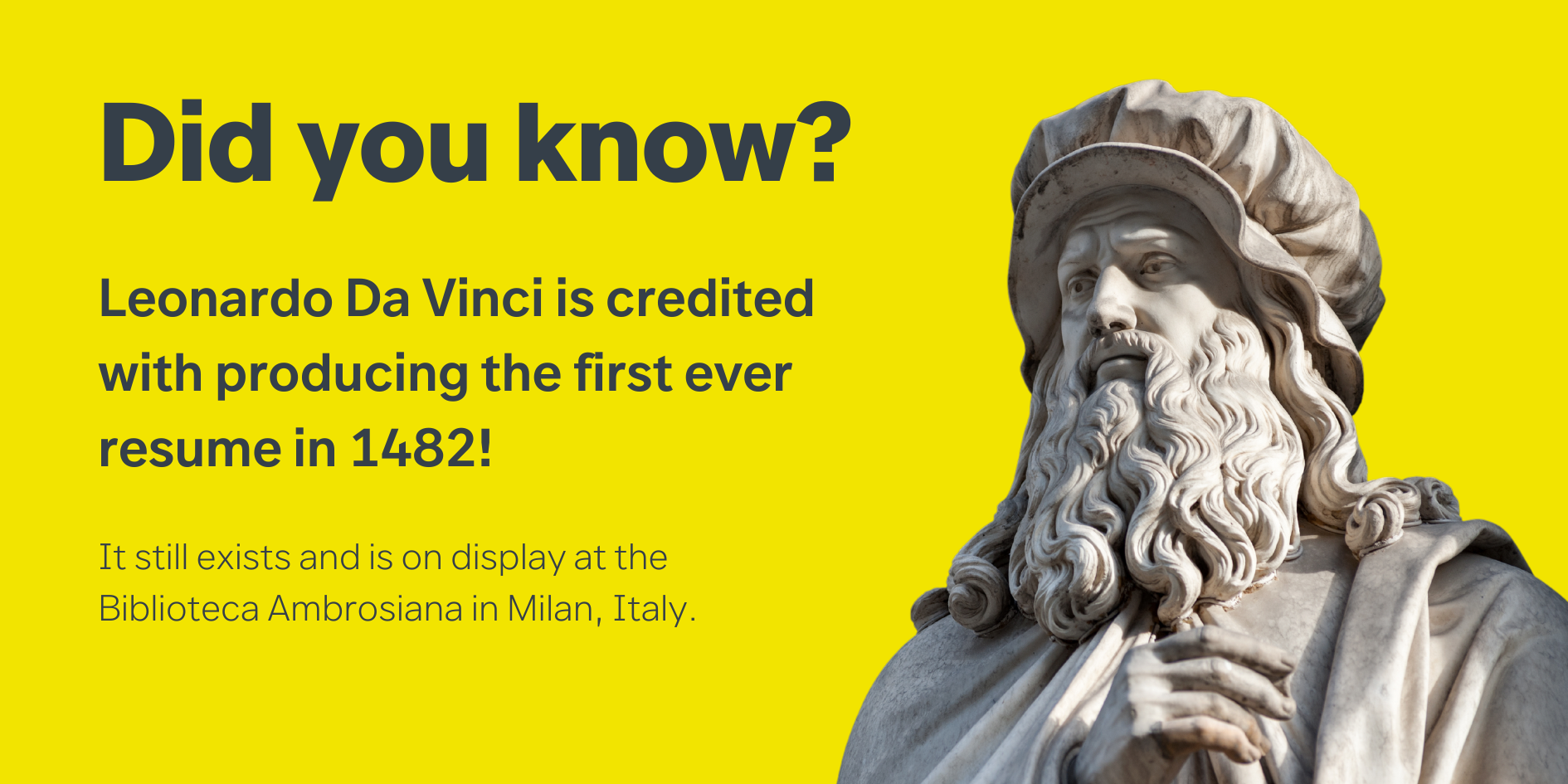Wait - CVs and Résumés aren’t the same thing?
job and career tips

job and career tips
CVs and resumes both serve the purpose of presenting yourself, including your qualifications, experience, and skillset to a potential employer, ideally in the best light possible. However, they do this in slightly different ways, and which document you choose depends on your background and where you are in the world. With the rise of Applicant Tracking Systems (ATS) and LinkedIn profiles, understanding both traditional and modern methods of presenting yourself to employers is important if you want to succeed. In this blog, we take a closer look at resumes and CVs, and their role in the contemporary workplace environment.
A CV, or Curriculum Vitae (Latin for "course of life"), is basically a full rundown of your professional history. From a technical perspective, a CV should include far more detail than a résumé, which is supposed to feature highlights only. A CV digs deep, listing out everything from your work experience and education to any research projects, publications, awards, and specific skills you've picked up along the way.
Because it covers so much, CVs tend to be long, usually two pages but can go for three or more depending on your background. They’re mostly used in fields like academia, research, and medicine, where it’s important to show exactly what you've achieved. In these areas, you might need to list your published papers, conference presentations, or technical skills to give hiring committees a clear sense of what you bring to the table. So, if you are going for a role that requires in-depth expertise, your CV is there to show the whole picture.
“Though platforms like LinkedIn are replicating much of the same content, having a CV as a stand-alone document is still valuable for recruiters and hiring managers. CVs give more in-depth information and CV design can give further insight into a candidates skillset and communication style, which is extremely important." - Madison Salmond, IT Recruitment Consultant

A résumé, in contrast to a CV, is a more focused summary of your skills, experience, and achievements. It is designed to give a quick snapshot of what you bring to a particular role. It is usually only one or two pages in length and highlights the aspects of your background which are most relevant to the job you are applying for. Since it is short and to the point, a résumé needs to be tailored for each position, emphasising the specific skills and experiences that best align with the opportunity you are applying for.
Résumés are widely used in corporate and non-academic job applications, especially in the United States, where hiring managers often spend just a few seconds scanning each one for key qualifications. In Australia, both resumes and CVs are commonly used, but with resumes generally being the preferred term in most industries.
Typical Australian resumes are roughly two to four pages long, with the content listed (qualifications, experience, achievements) being similar in format to other countries. In the UK and Europe, CVs are more commonly used, but the purpose is similar - résumés are just a bit briefer and more targeted. The idea is to showcase your most impressive or relevant achievements upfront, making it easy for recruiters to spot why you’d be a strong match for the role without wading through unnecessary details.

Given that LinkedIn has emerged as a such a significant factor in the modern hiring process, many are beginning to question whether traditional resumes or CVs are even necessary anymore. With LinkedIn publicly offering a snapshot of your professional journey, it can give recruiters enough information to use this platform instead of sifting through a stack of resumes. However, despite LinkedIn’s immense popularity, it hasn’t made the need for a resume or CV redundant – at least not yet.
Many companies still expect a tailored resume, especially since LinkedIn profiles tend to be more general and lack the personalisation of a resume. Resumes also let you refine your experience to highlight specific skills or experiences directly tied to the role, which your LinkedIn profile may fail to do, especially if your skills can be applied in different roletypes or industry settings. Some also point out the darker side of LinkedIn profiles.
"In my experience CVs tend to be more credible than a LinkedIn profile. The working history a candidate enters on the document they submit with an application is a formal, traceable declaration of their experience. While you’d hope that some level of peer exposure would compel honesty on the dates and details which appear on LinkedIn, digital details can be altered and revised so quickly, that it just doesn’t feel like people have committed to the facts as much as when they put it into a CV."
– Darren Leavey, Conventional Energy Recruitment Consultant
In fact, the presence of LinkedIn has shifted some aspects of resume culture. Older terms like “job history” and "employment record" have mostly disappeared, along with the long, narrative styles typical of older resumes formats. Today, resumes are increasingly skills-focused, designed for easy scanning, and have largely done away with some old-fashioned elements, like personal details or a statement of objectives.
Cover letters have also evolved in the LinkedIn era. While some companies still ask for them, especially for more traditional roles, many hiring managers focus on the resume or LinkedIn profile and may skip the cover letter entirely.
Yet, a well-crafted cover letter can still set you apart when it shows personality, motivation, and a clear link to the specific role or company. Customising cover letters is still wise for most applications, even if not every hiring manager reads them.
Cover letters should highlight your motivation for that specific role, making it easier for a recruiter to see you are a match. They are also useful for providing additional contexts or details to what is stated in your CV, giving explanations for things like job gaps or unusual roles which seem out of alignment with career trajectory.
In many companies, applicant tracking systems (ATS) will scan cover letters and CVs for keywords, so including job-specific terms in this document can help get your application closer to the top of pile. AI can be useful to generate a tailored draft, especially for inserting keywords or structuring points.
However, adding personal tweaks will make your cover letter sounds authentic and shows real enthusiasm — something which AI struggles to reflect.

An ATS is software used by employers to rapidly manage the large volumes of applicants they receive, especially for high-demand roles. ATS software automatically scans and sorts resumes, and filters candidates based on how closely their application corresponds with the keywords, experience, skills, and qualifications specified for the vacancy.
Here’s a closer look at how an ATS works:
Experience and qualifications filters: An ATS can filter resumes by specific levels of experience, education, or certifications. This allows recruiters to sift out candidates who don’t meet minimum qualifications to spend more time analysing and comparing the applicants who are best suited for the role.
By using ATS’ recruiters save time and improve efficiency, especially when dealing with hundreds of applicants. However, they can be a contentious topic, particularly amongst jobseekers concerned these systems could hurt their chances of selection.
While an ATS does exclude misaligned applicants, by reclaiming time that recruiters and hiring managers would otherwise waste sorting through unsuitable applicants, these systems ultimately allow the human element of the process to spend more time considering the qualities and differences of the most relevant applicants.
In an age where applying for a job can take mere seconds, an automated filtration system may be the only thing which can prevent an overwhelming influx of applications from clogging the process entirely. For candidates, the best course of action is to optimise their resume for ATS by strategically including relevant keywords, maintaining clean formatting, and focusing on the specific skills and qualifications listed in the job description.

While both CVs and resumes remain essential tools for sharing your skills and experience with potential employers, they are no longer the sole source of applicant information they once were. For jobseekers to be considered for employment opportunities, it is essential that they consider both their digital footprint – particularly on LinkedIn – and they must take the time to craft application documents which highlight their alignment with the specific requirements, down to the words and language used by their prospective employer.
By understanding the role which a resume, CV, cover letter and ATS play in the recruitment process and where and why they are used, you are better equipped to confidently present yourself to potential employers and set yourself apart in competitive job markets from substandard submissions.
Are you looking for a career change or just starting out in the job market? Whether you are interested in sectors such as Life Sciences, Mining, Renewables or Conventional Energy, you will find a broad variety of fascinating career opportunities.